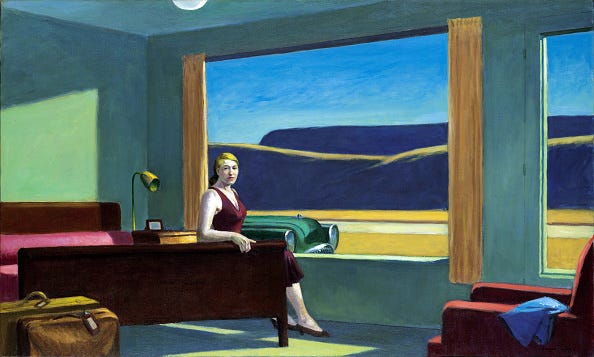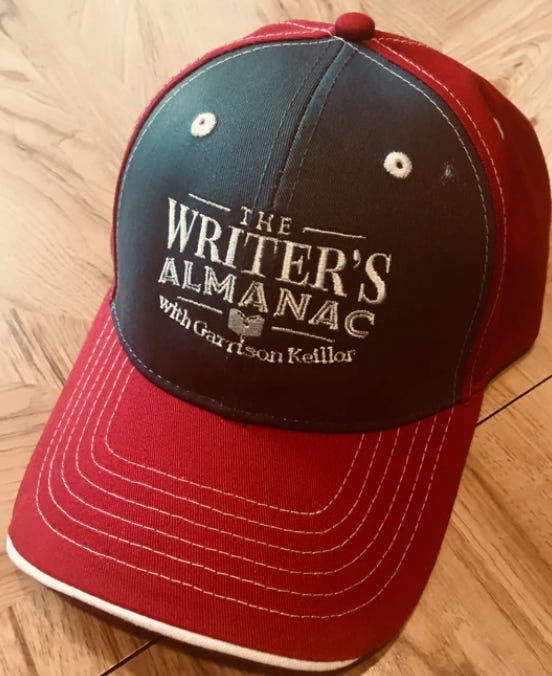TWA for Friday, July 22, 2016
“How to Take a Walk” by Leo Dangel from Home From the Field. © Spoon River Poetry Press, 1997.
ORIGINAL TEXT AND AUDIO - 2016
Today is the birthday of the American painter Edward Hopper, born in Nyack, New York (1882). As a young artist, he admired the work of Impressionist painters like Claude Monet; he loved the way they depicted light. He spent time in Paris, which was the undisputed center of the Western art world, and he worked to capture the unique quality of the city’s light in his early paintings Bridge in Paris (1906), Louvre and Boat Landing (1907), and Summer Interior (1909). His obsession with light carried him through his entire career; in 1962, he said he still considered himself an Impressionist, even though the style had long been out of fashion. He once said, “There is a sort of elation about sunlight on the upper part of a house.”
After his trips to Paris, Hopper returned to New York to work a day job as an illustrator. He made a pretty good living, although he didn’t enjoy the work. Meanwhile, he continued to produce paintings of his own, without much commercial or critical success. In 1913, he moved into an apartment in Greenwich Village, overlooking Washington Square Park, and that’s where he would live and work for the rest of his life. He married Josephine Nivison — a fellow painter he’d met in art school — in 1924. She was fairly successful, and he made a lot of professional connections as a result of their relationship. She nudged him to switch from oil paints to watercolors, and insisted on being the only female model in his paintings. He had a successful one-man show and his career took off, so he was able to quit the illustrator job that he hated. After that, he produced some of his best work, including Nighthawks (1942), which depicted a handful of lonely night owls through the window of a New York diner.
It’s the birthday of poet Emma Lazarus (1849), born in New York to a wealthy sugar refiner. Though an accomplished poet and ardent immigrant rights spokesperson, she is best known for penning “The New Colossus,” the sonnet that appears on a bronze plaque inside the Statue of Liberty’s pedestal and beseeches bystanders to “Give me your tired, your poor / Your huddled masses yearning to breathe free …”
It’s the birthday of Tom Robbins (1932), born in Blowing Rock, North Carolina. He decided he wanted to be a writer when he was a boy of five. His family was, he says, “kind of a Southern Baptist version of The Simpsons — except that my father never would have eaten pie off of the floor and I played the part of both Bart and Lisa.” They moved to Virginia when he was 11. He studied journalism at Washington and Lee University for a couple of years, but he left when he got in trouble for bad behavior and for failing to earn a letter in basketball. He hitchhiked around the country instead, and wound up in Greenwich Village.
He received his draft notice near the end of the Korean War and joined the Air Force. He really didn’t want to serve, but it never occurred to him to dodge the draft in Canada. He figured the best he could do was to find a noncombat post, so he studied meteorology at the University of Illinois, and then taught it to the South Korean Air Force. After the war, he returned to Virginia and studied art, then worked for the Richmond Times-Dispatch as a copy editor. After living in the Village and overseas, he no longer felt at home in the South; he got fed up and moved to Seattle in 1962, explaining, “I only knew two things about Seattle: one, it was a long way from racist, sexist, homophobic, hide-bound, purse-lipped, gun-toting, church-crazed, flag-saluting, bourbon-swilling, buzz-cut, save your Confederate money, boys! Richmond, Virginia; and two, there was reputed to be something not quite right about its weather.”
His books are full of whimsy and sly humor, a little mysticism, and a dose of the bizarre. His first book, Another Roadside Attraction, was published in 1971, and is about a married couple — proprietors of a hot dog stand — who steal the mummy of Jesus. Even Cowgirls Get the Blues (1976) features a hitchhiker with abnormally large thumbs. Jitterbug Perfume (1984) is about a king who lives for a thousand years and ends up as Einstein’s janitor. He’s written nine novels and one collection of essays, reviews, and short stories.
He’s also something of a punning philosopher. “Joy in spite of everything,” he says, “is yanking the bell rope despite physical affliction — it has become my Quasi Motto. One of my books is a hallucinogen, an aphrodisiac, a mood elevator, an intellectual garage door opener, and a metaphysical trash compactor.”
He describes his latest book as an “un-memoir,” called Tibetan Peach Pie: A True Account of an Imaginative Life (2014).
It’s the birthday of the novelist S.E. Hinton, born Susan Eloise Hinton in Tulsa, Oklahoma (1948). Growing up, she loved to read, but her biggest dream in life was to be a cowboy. So she wrote a couple of books about cowboys, and then when she was 15 she started working on a book called The Outsiders. She said: “Nobody believes that, so I usually say 16. My editors say 17, just in case.” She wrote and edited much of her novel during her junior year of high school, the same year that she got a D in her creative writing class. The Outsiders was the story of two rival gangs, based on the gangs at her high school in Tulsa — one of them was a group of kids from working-class families, the other, rich children of families who had made money in the oil business.
Hinton knew a friend of a friend whose mother wrote children’s books, so she sent the manuscript to that woman’s agent, and Viking paid her $1,000 for it. The Outsiders was published in 1967, during her first year of college at the University of Tulsa. She said: “Before it was published I thought I knew how to write. Afterward, I knew I couldn’t. I was a teen-age writer, which is similar to being a teen-age werewolf, only it doesn’t last as long.”
But The Outsiders became one of the most popular young adult books ever. It has sold more than 14 million copies, and continues to sell hundreds of thousands each year.
Be well, do good work, and keep in touch.®
*********************************
To Purchase this cap - Click Here





